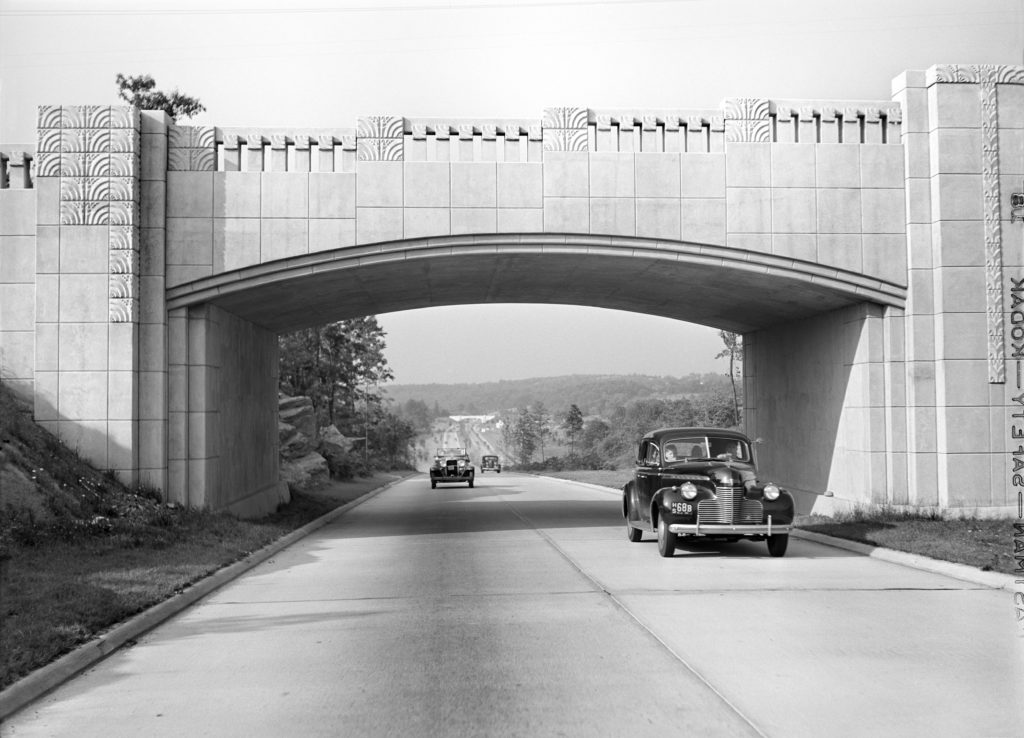The Parkway Home
The parkway evokes the best of Connecticut.

Fall in New England starts in the air. You walk outside one morning and the soft air of summer is gone. You breath and the air pierces your chest.
The breeze carries an earthy aroma. A few browned leaves appear on the ground heralding the coming decay. Within weeks the sky inevitably grays. The days get shorter. Everything darkens except the trees, at least at first. They pop pockets of brown-orange, scarlet, and yellow ochre. For about two weeks in October, the skies are lined with red- and orange-topped branches. Those colors carpet the ground in early November. By the middle of the month the remaining leaves fall, and the grounded leaves once red and orange soon become shriveled and brown. It gets cold outside. You need at least a hooded sweatshirt and, if you're the type, a scarf.
I grew up in a small Connecticut town. Some of my favorite memories come in fall. Playing football in the park and coming back cold, cut, and muddy; wrestling bass from the leaf-covered pond; walking the gravel paths at the far reaches of town. Because I am hopelessly nostalgic, I make a point of returning to Connecticut in the middle of October to drive the Merritt Parkway, the "Queen of the Parkways," with Chet Baker, Vince Guaraldi, and other autumnal jazz humming on my car radio.

The Merritt is one of Connecticut's crown jewels. It was conceived in the early 20th century to relieve traffic on Boston Post Road, then the main throughway between Boston and New York. Construction started in 1934 after the state secured nearly $350,000 in Public Works Administration funding. At the groundbreaking ceremony, Congressman Schuyler Merritt, a Republican and staunch New Deal opponent from Connecticut's 4th district, announced the purpose of the highway that would eventually bear his name.
"This great highway is not being constructed primarily for rapid transit but for pleasant transit. This county is fortunate in having such beautiful backcountry and it is our great duty to see that these beauties are preserved," he told the crowd.
Fairfield County then was a sleepy exurb of New York. Today it is the weekend home of Manhattanites and private-equity tycoons. The pastoral expanse that once characterized Fairfield is now banished to the county's northern periphery. But the Merritt remains largely as constructed. Traversing its long, windy roads is a window back in time.
The pair of two-lane roads stretch from Milford through the New York state line. They wind through Connecticut forests that now abut ritzy suburbs and Gold Coast development. Imposing trees enclose the parkway and line the median separating eastbound and westbound travelers. When fall arrives, the trees turn a dazzling array of reddish and yellowish hues, canopying the highway.
The on-ramps, such as they are, are short, and require decisive driving. The narrow roads were clearly built for smaller cars. There aren't any "shoulders." If you get in an accident, good luck.

But the parkway is an architectural marvel. The most distinctive feature of the Merritt is its collection of bridges, designed by George Dunkelberger. Each of the 69 bridges built along the highway is unique. Most employed some of the Art Deco ornaments popular at the time, with beveled chevrons and pilasters meant to simulate full columns. Several feature the Connecticut state seal engraved in their facades. Drive the Merritt and you'll stumble upon bridges with boxy statues of eagle's wings, reliefs of human faces, and classical scrolls.
"We believe that these bridges are pleasing to the eye, represent a radical departure from highway bridges, and are decidedly individual in character," Dunkelberg said of his work.
Every one of the original bridges was built before 1948, about the last year anything beautiful was built in the United States. Repairs have inevitably degraded their character, but many remain largely as constructed.
Subscribe Today
Get daily emails in your inbox
The parkway evokes the best of Connecticut. It has an almost regal character that reflects the patrician snobbery found in the Constitution State. Its forest-lined path is evocative of Connecticut's quaint heritage and the hamlets that remain in the state's northern half. In autumn the Merritt presents in vivid colors New England's fall season, with leaves frisbeeing down from the tree tops.
Fall, in New England and elsewhere, is a season of decay. It lends itself to nostalgia and reflection. Sinatra's "It Was a Very Good Year" sounds different in September. Even in D.C., I'm feeling the brisk autumn air in my lungs. Maybe I'll take a trip back home.
This New Urbanism series is supported by the Richard H. Driehaus Foundation. Follow New Urbs on Twitter for a feed dedicated to TAC’s coverage of cities, urbanism, and place.
Comments